
The Tools to Achieve Reading Success
Effective ~ Affordable ~ Easy-to-Use

Structure and Design of
Right Track Reading Lessons: A Highly Effective Step-by-Step Direct Systematic Phonics Program 2nd Edition
The reading lessons systematically and explicitly teach children how to read. The reading lessons include a series of multisensory activities described below.
1. Introduce and teach the new sounds - The lessons systematically introduce and teach the complete phonemic code.
2. Practice Sound Cards: The next activity in most lessons is to directly practice the print-to-sound relationship for the new sounds plus previous sounds.This simple but highly effective multisensory activity directly links the visual image of the print to the oral and auditory processes of saying and hearing the correct sound. Practice is always direct print-to-sound and accomplished by drilling with the sound cards for younger children by playing ‘sound’ games like memory, fishing for sounds, sound butterflies etc. See fun sound games
4. Word Making Activity: this highly effective multisensory activity develops phonemic awareness, builds a strong understanding of the phonetic nature of our language, and strengthens phonetic reading skills as well as blending and tracking. This word making activity incorporates kinetic, visual and auditory processes and reinforces basic subskills. These ‘sound tiles’ are particularly effective with remedial students. It is also lots of fun! The kids love this ‘game’. For examples of word making activity see Lesson 16 and Lesson 42.
6. Reading Words: The child practices reading a list of decodable words. Practice emphasizes correct phonological processing, blending, and tracking. These word lists are invaluable in teaching children HOW to read as reading cannot be accomplished by incorrect techniques such as picture or context clues. Reading the decodable word lists provides opportunity for the child to practice correct phonologic processing. The practice allows the child to master, integrate and apply essential skills to establish phonologic processing, the essential foundation for proficient reading. The extensive word lists in the Right Track Reading program provide the practice that is absolutely essential for building correct reading skills. To see sample word lists from actual lessons preview lesson 1&2, lesson 16, lesson 17, lesson 36, lesson 42 and lesson 77.
5. Sound changing activity: somewhat similar to word making except you use the sound tiles to emphasize changes in sounds within words. In addition to strengthening the same skills as the word making game, this activity/game uses the sound tiles to emphasize phonemic awareness and the attention to detail that is so important in reading. See lesson 16 for example of sound changing activity.
3. Write and Say the Sounds: Practice writing and saying the sound together. This essential activity of writing sounds uses kinetic, visual, auditory processes to directly link the printed letter to the sound.
See Resources for Users of Right Track Reading for free tracer letter pages.
7. Writing/spelling words: In this activity the child writes or spells words from the decodable lists. Writing words by sound directly strengthens phonologic processing.
8. Reading Decodable Sentences: These short sentences and later short paragraphs offer practice reading decodable text. They are especially important for beginners to learn how to read sentences and then longer passages. These sentences also allow you to begin some initial work on comprehension skills and the more complex elements of sentence structure. To see examples of decodable sentences and how rapidly decodable text expands please preview lesson 16, lesson 17, lesson 36, lesson 42 and lesson 77.
9. Lessons also introduce and directly teach common irregular words. Preview lesson 17 for an example of how irregular words are directly taught.
10. Review lessons are periodically incorporated into the sequence to allow for review of previous learned sounds and additional practice in reading decodable word lists and sentences. See Lesson 17 and Lesson 36 for a sample of review lessons.
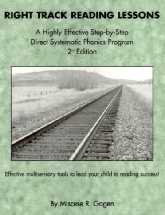
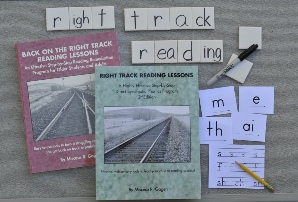
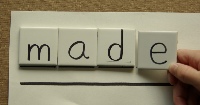







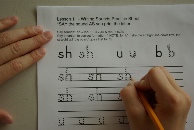



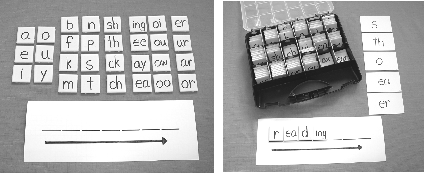


Copyright 2004-2013 Miscese R. Gagen ~ All Rights Reserved ~
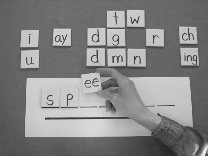
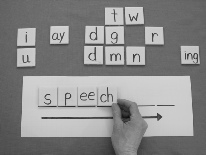
| Site Map Right Track Reading |
| Program Details - Right Track Reading Lessons |
| Program Details - Back on the Right Track Reading Lessons |
| Effective multisensory activities with sound tiles |
| Guarantee for Right Track Reading |
| Key Benefits Right Track Reading Lessons |
| Content Outline Right Track Reading Lessons |
| Right Track Reading cover front back |
| Design of Reading Lessons |
| Key Features Benefits Back on Track Reading Lessons |
| Content Outline Back on Track |
| Back on Track cover front & back |
| Frequently Asked Questions |
| FAQ phonemic awareness |
| FAQ phonemic code or sound knowledge |
| FAQ blending sounds smoothly |
| FAQ tracking reading left to right |
| FAQ vocabulary |
| FAQ comprehension |
| FAQ fluency |
| FAQ multisyllable words |
| Site Map Right Track Reading |
| Program Details - Right Track Reading Lessons |
| Program Details - Back on the Right Track Reading Lessons |
| Effective multisensory activities with sound tiles |
| Guarantee for Right Track Reading |
| Key Benefits Right Track Reading Lessons |
| Content Outline Right Track Reading Lessons |
| Right Track Reading cover front back |
| Key Features Benefits Back on Track Reading Lessons |
| Content Outline Back on Track |
| Back on Track cover front & back |
| Frequently Asked Questions |
| FAQ phonemic awareness |
| FAQ phonemic code or sound knowledge |
| FAQ blending sounds smoothly |
| FAQ tracking reading left to right |
| FAQ vocabulary |
| FAQ comprehension |
| FAQ fluency |
| FAQ multisyllable words |